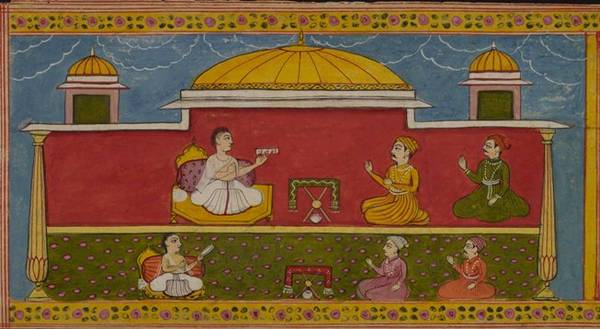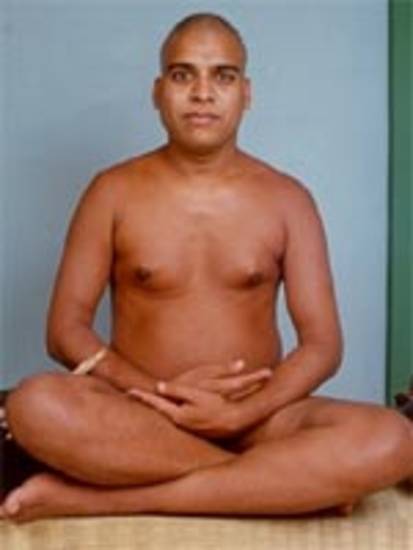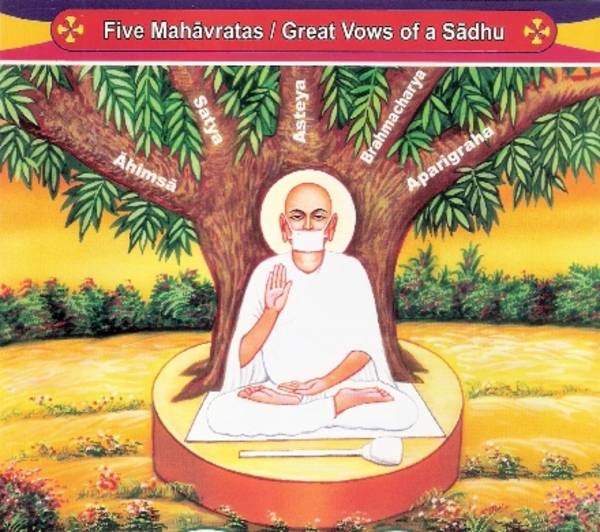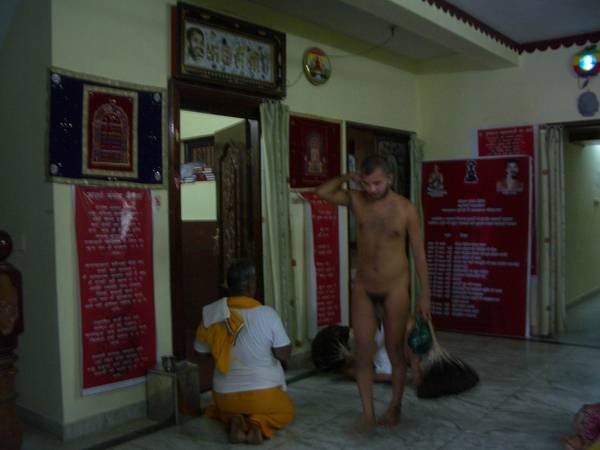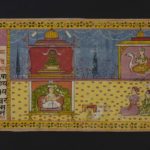Article: Vows
A vow is a solemn promise to do something or behave in a certain way. It is often associated with promising to follow certain strict rules of a religion. The vow – vrata in Sanskrit – is a significant part of the Jain religion. The vows Jains take may be described as vows of restraint, meaning that they vow to stop doing a particular thing. But Jain vows also involve actively doing something specific and positive.
The Jinas taught a twofold path to liberation – one for mendicants and one for lay people – with parallels between them and passages from the second to the first. Both mendicants and lay people can take vows, which are all voluntary. They are performed because they are linked to spiritual progress. Advancing spiritually is incredibly difficult, with most souls trapped in the cycle of birth for many lifetimes because of the karma attached to them. When a soul has no karma, it is liberated from the cycle of rebirth and can go to the siddha-śilā. Freeing the soul to realise its original purity is the ultimate goal of the Jain faith. Taking vows is a form of asceticism – tapas – which is believed to burn karma. Jains understand that keeping vows is demanding, because spiritual development is very hard, and those who make vows are celebrated within the Jain community.
Jains take special vows when they are initiated into the mendicant life, which are called the mahā-vratas or ‘great vows’. The vows relate to self-control, which help reduce karma and thus foster spiritual progress. Although monks and nuns may leave the mendicant life, their vows are usually lifelong. There are five mahā-vratas, of which the best-known is probably that relating to non-violence – ahiṃsā – which is the fundamental vow. Jains believe that only mendicants can advance all the way to final liberation, in large part because the mendicant vows are all ‘absolute’, meaning there are no degrees of severity. Lay Jains can develop spiritually only to a certain extent, but can choose to take the aṇu-vratas – ‘lesser vows’. Modelled on the mendicant vows, the five lay vows are less rigorous, because they are performed in the context of the householder life, but are still demanding.
There is a prohibition often dubbed the ‘sixth vow’, which forbids eating after dark, chiefly because of the potential for harming tiny living beings. The five vows are listed in the teachings of the 24th Jina Mahāvīra, passed down in the scriptures. His addition to the four vows presented by Pārśvanātha or Lord Pārśva, the 23rd Jina, sets out the requirement to be celibate as a separate vow. In addition, each great vow is accompanied by the bhāvanās – ‘realisations’ – in an important Śvetāmbara scripture. These bhāvanās help monks and nuns apply their vows in the mendicant lifestyle. Keeping the great vows is a key element of being a ‘perfect ascetic‘, which is the ideal of mendicant behaviour and spiritual development.
Equally, following the aṇu-vratas – the lay versions of the ‘great vows’ – is a fundamental part of being the ‘perfect lay Jain’. They form the first five of the 12 lay vows. The other seven vows supplement the lesser vows, helping the lay person live more like a mendicant in terms of renunciation and performance of religious duties.
From the earliest period, Jain teachers have acknowledged that the vows are difficult to keep and will be broken from time to time. Confession – ālocanā – and penance are thus important for both mendicants and laity, with the confession of lapses comprising a large element of the daily ritual of repentance – pratikramaṇa. Jains compensate for their transgressions by performing atonements – prāyaścitta – that their teacher gives them. These are usually fasts that vary according to the sin and the qualities of the sinner.
Both mendicant and lay vows are vows in the specific Jain usage of the Sanskrit term vrata. On the other hand, in daily life and speech ‘vrata’ also refers to all sorts of fasts connected with a specific date, marked by celebration at the end of the fast. This is a common usage of the term ‘vrata’, influenced by Hindu practices. In this meaning the word tap – fast – is also used.
Temporary resolutions to undertake a fast, without any reference to a specific date, are called pratyākhyānas and can be seen as a kind of vow as well.
One of the hardest vows is the sallekhanā – fasting to death. Both mendicants and lay people can make this vow, performed only in particular circumstances. The faster is greatly venerated for this vow, which is extremely difficult. This death helps the body to die peacefully and calmly, without passion, thus allowing the soul to move into its next life at a more advanced spiritual level.
Lay and mendicant paths
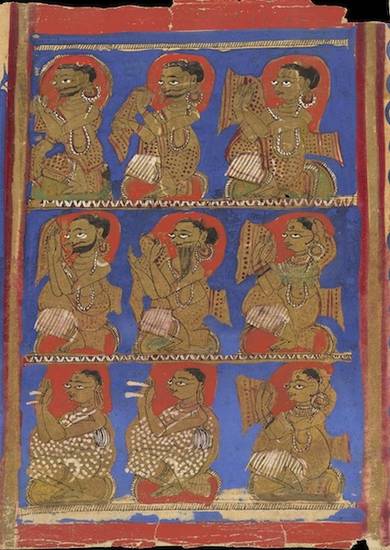
Fourfold community
Image by Wellcome Trust Library © Wellcome Library, London
The teachings of the Jinas provide a twofold route to liberation, one for mendicants and one for lay people.
Becoming a mendicant is often a long process, as it is a serious, lifelong commitment requiring leaving behind family, friends and possessions – in short, whatever creates attachment to life in the world. Mendicants are world-renouncers, and the mendicant path is the highest Jain ideal. Jain teachers have always been aware of how difficult this is. The gap between the everyday lives of mendicants and householders is very large. Since mendicants have always made up a small proportion of the Jain community, the ‘absolute’ nature of the mendicant life has long been recognised as suitable for relatively few Jains. When someone is initiated it is celebrated by lay Jains and mendicants, both because it is rare and in acknowledgement of the emotional, mental and physical difficulties of Jain monasticism.
If a lay Jain cannot embrace mendicant life, he or she can do his best to live as an ideal lay person engaged in worldly life as a householder, becoming a true upāsaka or śrāvaka. This path can be followed throughout life or as a preliminary to the mendicant life. Due to the features of their lifestyles, lay people and mendicants necessarily follow different rules. But a lay person can progress in the levels of restraints and thus in spiritual life and finally take initiation as a mendicant – dīkṣā. This is encapsulated in the ’11 steps of perfection – pratimā. The first step is to have right faith, which means:
- accepting the Jinas as the highest authority
- recognising the authority of Jain scriptures
- having faith in the seven or nine truths – tattvas.
The second step is to make the 12 lay vows. Successive restraints lead to the 10th and 11th step, when the boundary between lay and mendicant life thins away.
However, there is no obligation to move from one stage of the pratimā to the next, and lay Jains who choose to remain householders are considered to be spiritually ‘advanced’ lay people if they follow the 12 vows. They lead ascetic lives within the lay sphere and take part in worldly affairs to differing degrees, depending on the pratimā stage they have reached. Other lay Jains continue to advance along the pratimā steps until they are ready to perform the formal ceremony of renunciation – dīkṣā – which marks the change to becoming a monk or nun.
Types of vows
Vows – vratas – are the central element of Jain religious practice. Declaring a solemn promise, often in public, and then sticking to it is considered a good way to develop spiritually. The ascetic nature of vows of restraint is considered highly effective in destroying karma.
In the Jain technical usage of the term, vrata – a vow – is clearly defined in the Tattvārtha-sūtra, a scripture recognised as authoritative by both Śvetāmbaras and Digambaras:
To refrain – through manas [mind], speech and body – from violence, untruth, theft, sexual intercouse, and attachment-for-possession – that is called vrata
Tattvārtha-sūtra 7.1
English translation by Dixit of Pandit Sukhlalji‘s translation, 1974: 251
Vows are of two types, depending on whether they apply to the mendicant or to the lay path:
- absolute or total – mendicants
- limited or partial – lay Jains.
Monks and nuns take five ‘great’ or ‘absolute’ vows – mahā-vratas – on their initiation. These vows are considered ‘absolute’ because they are all or nothing – there is no grey area in between. Being able to stick to these vows throughout a lifetime is an important element of the mendicant lifestyle. Monks and nuns live according to strict rules, which are in large part designed to support these vows.
For the lay part of the Jain community the path to liberation is encapsulated in a set of 12 vows, known as the:
- aṇu-vratas – five ‘lesser vows’
- guṇa-vratas – three ‘reinforcing vows’
- śikṣā-vratas – four ‘vows of training’.
The first category comprises versions of the mendicants’ five vows but is less restrictive than the mahā-vratas, hence the name. These vows are often described as ‘limited’ or ‘lesser’ because they:
- take account of the responsibilities of a householder
- are often limited in time
- are often limited in scope.
The two other categories are meant to cover restraints in all possible areas of lay life and contribute to strengthening the five main lay vows.
Taking mendicant or lay vows relies on the individual having correct faith and correct knowledge – samyag-darśana and samyag-jñāna. These are the first two of the three gems. Observing the vows illustrates the third gem, which is correct conduct – samyag-cāritra. It can be done only if the fundamental Jain principles have been recognised as true and understood properly in their complexity.
Mendicant vows
The five great vows of Jain mendicants – mahā-vratas – are the keystone of their monastic status and aid them on the path to liberation. Jains believe that the 24th Jina, Mahāvīra, handed down the vows as a vital part of his teachings. Thus they can be found in the earliest holy texts of the Jain faith.
In some Śvetāmbara scriptures, the mahā-vratas are followed by a sixth vow, which prohibits eating after sunset – rātri-bhojana-vrata. Mahāvīra added a fifth vow to the four set out by his predecessor, Pārśvanātha or Lord Pārśva, making it clear that celibacy or chastity should be a separate vow from that time on. This takes account of the worse spiritual conditions of this era in time. The Śvetāmbara scripture Ācārānga-sūtra supplements the five vows with five bhāvanās – ‘realisations’ – which help with the practical side of living with the great vows. The key text for all Jain sects, the Tattvārtha-sūtra discusses these bhāvanās in some detail.
The central importance of the great vows to spiritual development is emphasised in Jain writings. Only those who have taken the great vows – namely, mendicants – can make enough spiritual progress to gain, in due course, final liberation. The rules that are set out by the 24th Jina are very precious to those who truly wish to be emancipated from the cycle of rebirth.
Once they are mendicants, individuals may also perform extra vows in addition to their normal monastic practices. For example they may vow to fast every other day or to accept alms only from donors who fulfil certain criteria. The most famous instance is the 24th Jina Mahāvīra, who vowed not to speak or accept alms from anyone except a weeping princess offering black beans in a certain time and place. Only Candanā fulfilled these conditions, in an exemplary tale well known among Jains.
Five vows
Jain men and women renounce the householder life when they become mendicants. As part of their initiation, they take the decision to follow the five ‘absolute’ vows or mahā-vratas for the rest of their lives.
Also called the ‘fundamental vows’, the mahā-vratas are:
- non-violence – ahiṃsā
- truth – satya
- non-stealing – acaurya or asteya
- celibacy – brahmacarya
- non-attachment or non-possession – aparigraha.
These vows are ‘absolute’ for the mendicant. This is the traditional order of the vows, clearly set out by Māhavīra, the 24th Jina. At the time of initiation – dīkṣā – a monk or a nun pronounces the vows in front of his or her religious teacher.
Making these five absolute vows is a key part of becoming a monk or nun. It is rare for a mendicant to return to the life of a lay person, and Jain society does not approve of it.
Mendicants decide to follow these vows in three ways, namely in:
- mind – manas
- speech – vāc
- action – kāya, literally ‘body’.
This resolution applies to actions that the mendicants directly perform and also to indirect involvement or implication. As part of this threefold approach, Jain mendicants also resolve not to:
- cause or encourage anybody else to sin by breaking vows in any of these three ways
- approve of anybody who would transgress in these ways.
Six vows
In Śvetāmbara canonical scriptures, which can be considered fairly early, the set of the five great vows is supplemented with a sixth. This is not eating at night or, more precisely, after sunset – rātri-bhojana-vrata.
The second Aṅga, the Sūtrakr̥tānga, thus has the phrase ‘the excellent great vows together with (the absention from) eating at night’ (1.2.3.3). In the standard passage from the Daśa-vaikālika-sūtra, it has become part of the full set, as ‘the sixth vow’.
Now follows, o my Master, the sixth vow, the abstention from eating at night. O my Master, I renounce all eating at night, be (the food) consistent, liquid, (food) spiced or sweetened. I (shall myself) not eat at night nor cause (anything) to be eaten by others at night, nor allow others who eat at night, to do so. As long as I live, I (shall) not eat at night (etc.). O my master, I have taken the sixth vow, (concerning) the abstention from eating at night.
Daśa-vaikālika-sūtra, chapter 4
translation by Schubring, 1932: 85–86 = 1977: 203–204
This prohibition could have had its origin in common sense, as seeking alms in the dark could be simply dangerous for safety reasons.
But Jain discourse underlines that eating at night implies injuring small living beings. Thus this vow appears as a special application of the first great vow – non-violence. The question then arises of its status. Should it be considered as included in the first vow? Or should it be singled out as a separate vow? A convenient summary on this debate is found in Pandit Sukhlalji’s translation of the Tattvārtha-sūtra (1974: 259–260; in the JAINpedia e-Library).
Four vows
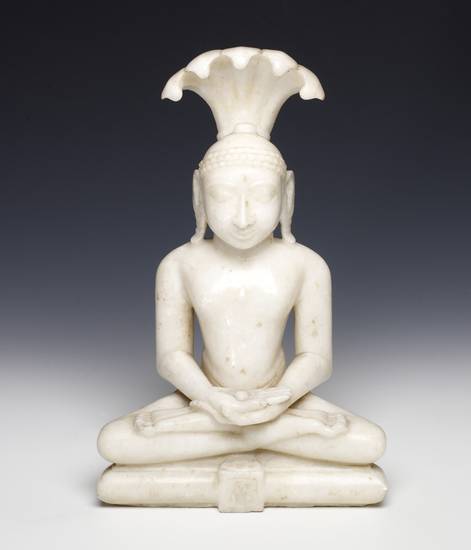
Figure of Pārśvanātha
Image by Victoria and Albert Museum © Victoria and Albert Museum, London
In the Śvetāmbara scriptures, the teaching of five or six vows is associated explicitly with Mahāvīra in several places. Earlier, in the time of the Jina‘s predecessor Pārśvanātha or Lord Pārśva, there were only four vows, which consisted of avoiding:
- violence
- lying
- taking what has not been given
- possession.
This list is found in the section called ‘Four items’ of the Sthānānga-sūtra, the third Aṅga. It lacks the vow of celibacy. In Pārśva’s teaching, this is equally important, but is included in that of non-possession and not singled out.
The contrast between the two views is presented in a dialogue between Keśi, disciple of Pārśva, and Gautama, a follower of Mahāvīra, as reported in the Uttarādhyayana-sūtra (chapter 23, verse 23). There this alteration is explained with reference to the different periods of time, and can be interpreted as follows:
In other words, the first and last fordmakers [= Jinas] formulated their teachings in the form of the five Great Vows in which prohibition of sexual relations is prescribed as a result of the inadequacies of their followers, whereas such a ban would have been understood by the followers of the other fordmakers as being incorporated in the prohibition on possession
Dundas, 2002: 31
Dialogues between Mahāvīra and monks who continued to follow Pārśva’s teaching are provided in the fifth Aṅga of the Śvetāmbara canon, the Vyākhyā-prajñapti. These show that when the monks convert to Mahāvīra’s doctrine, they give up the fourfold restraint and take the five great vows.
Bhāvanās
In the description of the Ācārānga-sūtra, each great vow is followed by five clauses, called the bhāvanās – ‘realisations’. The statement of each vow is general and brief, with the clauses detailing how the vows are applied in more concrete terms. Considering and observing these additional rules help the mendicant to be sure that the vow is perfectly executed (Dundas 2002: 158). The recurring idea is that the bhāvanās contribute to mendicants staying steadfast in their vows (Tattvārtha-sūtra 7.3).
For instance the bhāvanās of the first vow, non-violence, are to:
- be careful in one’s movements
- avoid violent thoughts, such as quarrels, focusing instead on benevolent thoughts
- ‘look for a thing, to receive it and to utilize it’ with attentiveness
- be careful when picking up and laying down monastic equipment
- inspect food and drink before eating and drinking.
For more details see Pandit Sukhlalji’s translation of the Tattvārtha-sūtra (1974: 254–266; in the JAINpedia e-Library).
The bhāvanās are primarily discussed in the context of mendicants’ vows.
Even so, their nature is such that any and every practiser of vratas can increase or reduce their number as might suit his own level of spiritual development.
Sukhlalji 1974: 257
Lay vows
Like the mendicant vows, the 12 lay vows are partly meant to help cultivate mindfulness of one’s actions and thoughts. Controlling these is a way of making spiritual progress, as it helps, eventually, to earn merits and destroy the karma weighing down the soul. This is a vital step in moving towards final liberation of the soul, the ultimate goal in Jainism. Both Śvetāmbaras and Digambaras recognise the 12 vows, even though details of their contents may vary.
The ideal of the perfect lay man is expressed clearly in the seventh Aṅga of the Śvetāmbara canon, the Upāsaka-daśāḥ. The stories in ten chapters focus on ten wealthy and powerful householders who are inspired after they have listened to Mahāvīra’s teaching. However, they do not become mendicants, but decide to live as an upāsaka – a follower of ideal Jain lay conduct. They adopt the 12 lay vows, which Mahāvīra describes as the:
- five ‘minor’ vows – aṇu-vratas
- three guṇa-vratas
- four śikṣā-vratas.
The possible transgressions – aticāras – of each of the lay vows are also described at length. Taking these vows has a definite impact on the way these lay people practise their professions.
The purpose of these stories is to show that living the life of a perfect lay Jain is not inferior to that of a perfect ascetic. In the final stage of their itinerary, these lay men put their sons in charge of household responsibilities. They are thus able to reach a level similar to that of a monk in their mental purity and life of withdrawal. They follow the path of the 11 pratimās, which define the stages of spiritual progress. The men’s practice of austerities finally results in their reaching the third type of knowledge – clairvoyance. Human beings can gain this knowledge only after performing special meditation or ascetic practices. The wives of these lay men follow their examples, adopting the same way of life.
Thus the Jains have always been aware of the crucial place of the lay community in the Jain faith. In the course of time a full-fledged literature has developed, centring on all the areas of lay life, depicting in details the vows, their applications and conditions when the possibility of breaking the vows is high. These are the śrāvakācāras – lay conduct – treatises by Śvetāmbara or Digambara mendicants (Williams 1963). In parallel to the prescriptive texts, Jain religious teachers have written a number of stories to illustrate vows in practice and produced a rich répertoire of characters.
Lay people can also practise asceticism – tapas – without making formal vows and observe temporary fasts – called vratas in the non-technical sense of the term. This is probably more common nowadays.
Aṇu-vratas

Ācārya Tulsi
Image by Pramodjain3 © CC BY-SA 3.0
This is the first category of the 12 vows that define the lay Jain path to liberation. They are modelled on the five mendicant vows and are identical among Śvetāmbaras and Digambaras. Lay Jains take ‘lesser’ or ‘limited’ versions of the mendicant vows of:
- non-violence – ahiṃsā
- truth – satya
- non-stealing – acaurya or asteya
- celibacy – brahmacarya
- non-attachment or non-possession – aparigraha.
The aṇu-vratas apply the five mendicant vows – mahā-vratas – within the daily life of a householder. They are less rigorous than the mendicant vows but are still challenging.
The aṇu-vratas are intended to reduce behaviour that may injure:
- other living beings
- the individual, by hampering spiritual development.
A lay Jain taking the five lesser vows resolves not to:
- do any forbidden thing with mind, speech and body – kṛta
- cause harm to other living beings – kārita
- approve of such actions – anumodana.
These vows are considered key to the concept of the ideal lay Jain.
Even so, it is quite rare for contemporary Jains to take one or more of these formal vows. Nevertheless, there has been at least one important initiative to adjust the system of lay vows to the modern context of post-Independence India. This is the creation of the Aṇuvrat movement by the late Ācārya Tulsi of the Terā-panthin sect.
Other lay vows
The five vows in their ‘lesser’ version are the basis of lay Jain conduct and are fixed in all sources, from the earliest ones. They have been supplemented by additional vows that encompass all areas of lay life, especially that of people engaged in business. The vow of abstaining from food after sunset is often brought into the system, as it is for mendicants.
There is less unanimity about the way to arrange and name these additional vows than there is for the lesser vows – aṇu-vratas. In Śvetāmbara sources they are grouped into the two categories of:
- three guṇa-vratas – ‘reinforcing vows’
- four śikṣā-vratas – ‘vows of training’.
This arrangement is also found in many Digambara sources, but some of them designate all the seven vows as śīlas – ‘moral virtues’.
Examining the sources in depth shows that there are variations in the names and sequence of these vows between authors (see table in Williams 1963: 56), even of the same affiliation. Here the standard Śvetāmbara canonical list is given as reference.
Three ‘reinforcing vows’
The guṇa-vratas are ‘special cases’ of the aṇu-vratas, which supplement them in specific areas of lay life. The guṇa-vratas are long-term restraints to which the lay person may commit himself. The lay Jain decides what the limit should be in these areas either alone or in consultation with a mendicant.
|
|
Details |
|
|---|---|---|
|
1 |
Fixing a limit in all directions to circumscribe the area of action, for example limiting travel. The more movements are restricted, the fewer beings are hurt |
|
|
2 |
bhogopabhoga-parimāṇa-vrata |
Fixing a limit to the consumption of food, perfumes and so on and to consumerism. Śvetāmbaras add to this the ‘ban on 15 trades’, which implies destruction of plants, trading in alcohol and so on (Williams 1963: 117 ff.) |
|
3 |
anartha-daṇḍa-vrata |
This ‘abstaining from harmful activities that serve no useful purpose’ (Williams 1963: 123) lists traditionally harmful activities as:
Digambaras add the reading of wrong things, which encourage passions and injury – duḥśruti |
Four ‘vows of training’
The śikṣā-vratas are not prohibitions but commitments to religious practices to be performed on a daily or regular basis. The spirit of some of the four vows is to bring the lay person closer to living like a mendicant through various renunciations.
|
|
Details |
|
|---|---|---|
|
1 |
sāmāyika-vrata |
Regular performance of the sāmāyika ritual, which involves equanimity of mind and reciting religious formulas, mostly in the presence of a religious teacher. It brings the lay person spiritually close to being a mendicant. |
|
2 |
The ‘restriction of one’s activities to a certain area for a certain period of time’ (Dundas 2002: 190) is undertaken in the same spirit as the first guṇa-vrata. The Digambaras put it in that category. |
|
|
3 |
posadhopavāsa-vrata |
Undertaking partial or full fasts on a fixed day of the lunar month, especially the 8th, 14th and on full-moon dates. More generally, being engaged in virtuous acts and putting limitations on bodily care, sexual relations and involvement in worldly activities. |
|
4 |
atithi-saṃvibhāga-vrata or dāna |
Giving alms to worthy recipients, meaning Jain mendicants, in conformity with rules defining what is to be given and how. More broadly, it relates to religious charity. |
Reading
- ‘Souper de jour: quatrains’
Nalini Balbir - Indologica Taurinensia: Professor Colette Caillat Felicitation Volume
volume 14
International Association of Sanskrit Studies; 1987–88
- ‘The “Sunday’s vow”: A Digambara Narrative of North India and its London Illustrated Manuscript’
Nalini Balbir - Sūrya-prabhā: Studies in Jainology – A Commemoration Volume in Honour of Ācārya 108 Śrī Sūrya Sāgara Jī Mahārāja
edited by Hampa Nagarajaiah, Arvind Kumar Singh and Navneet Kumar Jain
Acharya Shanti Sagar Chhani Smriti Granthamala; Muzaffarnagar, Uttar Pradesh, India; 2010
- ‘Lay Atonements: Investigation into the Śvetāmbara Textual Tradition’
Nalini Balbir - Prof. W. B. Bollée Felicitation Volume
edited by Peter Flügel
Routledge; London, UK; forthcoming
- Śrī parvakathādi vividha viṣaya saṃgraha
Muni Bhuvanavijaya - Bhinmal, Rajasthan, India; 1980
- ‘La Jñānapañcamīkathā de Maheśvarasūri’
Christine Chojnacki - Bulletin d’Études Indiennes
volume 15
Association Française pour les Études Indiennes; 1997
- ‘La célébration de la connaissance: normes et pratiques d’un vœu jaina’
Christine Chojnacki - La norme et son application dans le monde indien
edited by Marie-Luce Barazer-Billoret and Jean Fezas
Etudes thématiques series; volume 11
École Française d’Extrême-Orient; Paris, France; 2000
- The Jains
Paul Dundas - Library of Religious Beliefs and Practices series; series editor John Hinnels and Ninian Smart; volume 14
Routledge Curzon Press; London, UK; 2002
- ‘Negotiating Karma, Merit, and Liberation: Vow-taking in the Jain Tradition’
M. Whitney Kelting - Dealing with Deities: The Ritual Vow in South Asia
edited by Selva J. Raj and William P. Harman
State University of New York Press; Albany, New York, USA; 2006
- ‘The role of the layman according to the Jain canon’
K. R. Norman - The Assembly of Listeners: Jains in Society
edited by Michael Carrithers and Caroline Humphrey
Cambridge University Press; Cambridge, UK; 1991
- Vrata-tithi-nirṇaya
Siṃhanandī - edited by Nemichandra Shastri
Jñānapīṭha-Mūrtidevī-Jaina-Granthamālā series; volume 19
Bhāratīya Jñānpīṭha; Kashi, Uttar Pradesh, India; 1956
- Commentary on Tattvārtha Sūtra of Vācaka Umāsvāti
Pandit Sukhlalji - translated by K. K. Dixit
L. D. series; volume 44
L. D. Institute of Indology; Ahmedabad, Gujarat, India; 1974
- Introduction to Sugandhadaśamī Kathā
A. N. Upadhye - edited by Hiralal Jain
Bhāratīya Jñānapīṭha; Delhi, India; 1966
- Historical Dictionary of Jainism
Kristi L. Wiley - Historical Dictionaries of Religions, Philosophies, and Movements series; series editor Jon Woronoff; volume 53
Scarecrow Press; Maryland, USA; 2004
- Jaina Yoga: A Survey of the Mediaeval Śrāvakācāras
Robert Williams - London Oriental series; volume XIV
Oxford University Press; London, UK; 1963
Links
- Five Great Monastic Vows
-
Pravin K. Shah writes about the Five Great Vows taken by Jain monks and nuns. The information is provided by the Jainism Literature Center, associated with the Faculty of Arts and Sciences at Harvard University.
http://www.fas.harvard.edu/~pluralsm/affiliates/jainism/jainedu/5greatvows.htm
- Lay vows
-
Digambara specialist Vilas Sangave has written this piece on the 12 lay vows for the Jainworld website.
- Jain doctrine
-
Jainworld.com gives a detailed explanation of key elements of Jain doctrine, including the:
- three gems
- concept of knowledge
- lay conduct
- vows
- penance.
- A Jina renounces
-
This highly decorated page from a 15th-century manuscript of the Kalpa-sūtra is provided by the National Gallery of Australia. A young man performs the rite of keśa-loca – ‘pulling out of the hair’ – which indicates indifference to the body. It is part of the initiation ceremony of dīkṣā, in which an initiate renounces the world and becomes a mendicant. He is watched by Śakra, king of the gods who takes an active role in the lives of the 24 Jinas.
http://artsearch.nga.gov.au/Detail-LRG.cfm?IRN=177852&View=LRG
- Re-enactment of the story of Candanabālā
-
This slideshow displays the re-enactment of the story of Candanabālā, who offered Mahāvīra appropriate food to break his fast. Sold into slavery, the beautiful princess has her lovely hair chopped off and is starved for three days. Even so, her first act when released is to offer alms to a passing mendicant. He is Mahāvīra, who becomes the 24th Jina, and he has been fasting for nearly six months. Candanabālā’s act of selfless charity despite her suffering causes her hair to be restored and her true identity revealed. The story of this virtuous woman – one of the soḷa satī – emphasises the importance of offering alms correctly. Acting out such stories is an important part of many Jain festivals. This re-enactment on YouTube was performed by Śvetāmbara Jains in Melbourne, Australia during the festival of Paryuṣaṇ in 2010.
- Group initiation of Digambara monks – part 4
-
At the end of their group ceremony of renunciation – dīkṣā – 25 new Digambara monks are blessed by their teacher Vidyāsāgar. He also consecrates their water pots –kamaṇḍalu – and blesses some newly initated novices – kṣullaka – who are dressed in white. Both groups of mendicants hold their characteristic peacock-feather brooms – piñchī. The new monks have ritually taken off their clothes, which is a sign of advanced spirituality in Digambara Jainism. Then Vidyāsāgar preaches to the assembly of lay Jains. White-clad nuns – āryikā – are at the front of the crowd. Found on YouTube, this collective ceremony in Hindi took place on 21 August 2004 in the so-called Dayoday Tirth, Delwara Ghat, in the town of Jabalpur in Madhya Pradesh on the bank of the river Narmada. Watch the first part of the ceremony at http://www.youtube.com/watch?v=txYBw9ke-aU
- Śvetāmbara initation candidates in the crowd
-
As part of the renunciation ceremony to become a monk or nun – dīkṣā – the initiation candidates pass through a joyful crowd, who throw sandalwood powder over them. The initiates have already shaven and plucked out their hair and wear the white monastic robe of Śvetāmbara mendicants. This undated ceremony on YouTube takes place in Gujarat.
- +
- aAbhavya
- aAbhinandana
- aAbhiṣeka
- aĀcāra
- aĀcārāṅga-sūtra
- aĀcārya
- aAchalbhrata
- aAḍhāī-dvīpa
- aAdharma
- aAdho-loka
- aAdhyayana
- aAdvaita Vedānta
- aĀgama
- aAghātīya
- aAghātīya-karman
- aAgnibhuti
- aAgra
- aĀhāra
- aAhiṃsā
- aAhimsa Day
- aAjita
- aAjīva
- aAkampit
- aĀkāśa
- aAkbar the Great
- aAkṣaya-tṛtīyā
- aAlauddin Khalji
- aAlbert Einstein
- aAllah
- aAlms
- aĀlocanā
- aAloka-ākāśa
- aAmāri
- aAmbikā or Kūṣmāṇḍinī
- aAnagāra
- aAnanta
- aAnarthadaṇḍa
- aAnaśana
- aAnekānta-vāda
- aAṅga
- aAniconism
- aAnojjā
- aAntarāla
- aAntarāya-karma
- aAṇu
- aAṇu-vrata
- aAnukampā
- aAnuprekṣā
- aAnusvāra
- aApabhraṃśa
- aAparigraha
- aAra
- aĀrambha
- aĀrambhaja
- aĀratī
- aArdhamāgadhī Prākrit
- aArhaṃ
- aArhat
- aArśana-āvaraṇīya-karma
- aĀrta-dhyāna
- aĀryikā
- aĀryikā Jñānamati
- aĀśātanā
- aĀścarya
- aAscetic
- aAsceticism
- aAshram
- aAspiration
- aĀsrava
- aAṣṭa-maṅgala
- aAṣṭāpada
- aAstikāya
- aAstrolabe
- aAsura
- aAtheism
- aAticāra
- aAtiśayakṣetra
- aAtithisaṃvibhāgavrata
- aĀtma-vāda
- aĀtman
- aAuṃ
- aAurangzeb
- aAuspicious
- aAusterity
- aAvadhāna
- aAvadhi-jñāna
- aĀvaraṇī-yakarman
- aAvasarpiṇī
- aAvatāra
- aAvidyā
- aAxiom
- aĀyāga-paṭa
- aĀyambil
- aĀyu-karma
- aĀyurveda
- bBabur
- bBāhubali
- bBaladeva
- bBālāvabodha
- bBandha
- bBasadi
- bBazaar
- bBhadrankarvijay
- bBhagavant
- bBhaktāmara-stotra
- bBhakti
- bBhale
- bBharata
- bBhāṣā
- bBhāṣya
- bBhaṭṭāraka
- bBhāva
- bBhāva-pūjā
- bBhāvanā
- bBhavana-vāsin
- bBhavya
- bBhavyatva
- bBhaya
- bBhoga-bhūmi
- bBhogopabhoga
- bBodhi
- bBollywood
- bBrahmā
- bBrahma-deva
- bBrahmacārī
- bBrāhmaṇa
- bBraj Bhāṣā
- bBright fortnight
- bBritish Raj
- bBuddha
- bBuddhi-sagar
- bBuddhism
- bBuddhist
- cCaitya
- cCaityavāsin
- cCakravartin
- cCakreśvarī
- cCāmara
- cCandanā
- cCandragupta
- cCandraprabha
- cCanon
- cCāritra
- cCāritramohanīya-karman
- cCarũrī
- cCaste
- cCaturvidha-saṅgha
- cCaturviṃśati-stava
- cCāturyāma
- cCE
- cCelibacy
- cCha
- cChadmastha
- cChastity
- cCheda-sūtra
- cChristian
- cChristianity
- cClergy
- cCloning
- cColophon
- cCommentary
- cConch
- cConfession
- cCongregation
- cConsecration
- cCosmology
- cCremation
- cCrore
- cCult
- cCūrṇi
- dDādā-guru
- dDalit
- dDāna
- dDaṇḍa
- dDark fortnight
- dDarśana
- dDarśanamohanī-yakarman
- dDaśa-lakṣaṇa-parvan
- dDeity
- dDelhi Sultanate
- dDerāsar
- dDeśāvakāśika-vrata
- dDetachment
- dDevanāgarī
- dDevānandā
- dDevarddhi-gani
- dDevotee
- dDhamal
- dDhanuṣ
- dDhāra
- dDharma
- dDharma-dhyāna
- dDharma-sāgara
- dDharmastikaya
- dDhātakīkhaṇḍa
- dDholak
- dDhyāna
- dDiaspora
- dDig-vrata
- dDigambara
- dDīkṣā
- dDisciple
- dDīvālī
- dDivya-dhvani
- dDNA
- dDoctrine
- dDogma
- dDonor
- dDoṣa
- dDravya
- dDravya-pūjā
- dDrone
- dDuṣamā
- dDuṣamā-duṣamā
- dDuṣamā-suṣamā
- dDveṣa
- dDvīpa
- eEast India Company
- eEightfold Path
- eEkānta-vāda
- eEkendriya
- eElder
- eElders
- eEschatology
- eEtc up to
- fFarmān
- fFast
- fFatehpur Sikri
- fFestival
- fFestschrift
- fFiruz Shah
- fFly-Whisks
- fFolio
- fFour Noble Truths
- gGaccha
- gGaṇa
- gGaṇadhara
- gGanadharavada
- gGaṇeśa
- gGaṇin
- gGarba
- gGarbha
- gGarbha-gṛha
- gGaruḍa
- gGati
- gGene
- gGenomics
- gGhātī-yakarman
- gGhātīya
- gGhaznavid
- gGhiyasuddin Tughlaq
- gGhurid
- gGloss
- gGotra-karma
- gGujarāt
- gGujarati
- gGuṇa
- gGuṇa-sthāna
- gGuṇa-vrata
- gGupti
- gGuru
- gGuruṇī
- hHagiography
- hHajj
- hHaṃsa
- hHaribhadra
- hHariṇaigameṣin
- hHasta
- hHeresy
- hHiṃsā
- hHindi
- hHindu
- hHinduism
- hHīravijaya
- hHoroscope
- hHrīṃ
- hHumayun
- hHymn
- iIconoclasm
- iIconography
- iIdol
- iIndian Independence
- iIndology
- iIndra
- iIndrabhūti Gautama
- iIndriya
- iInitiation
- iIntercession
- iInvocation
- iIQ
- iIslam
- iIslamicate
- iIṣṭadevatā
- iĪśvara
- jJagat
- jJahangir
- jJain
- jJaina Devanāgarī
- jJaina Śaurasenī
- jJaina-dharma
- jJainaśāsana
- jJainness
- jJaisalmer
- jJamāli
- jJambū-dvīpa
- jJames Burgess
- jJanma
- jJanma-kalyāṇa
- jJarā
- jJāti
- jJina
- jJina-āgama
- jJina-bhavana
- jJina-bimba
- jJina-mātā
- jJinacandra-sūri
- jJinadatta
- jJinaprabha
- jJīva
- jJñāna
- jJñāna-āvaraṇīya-karma
- jJñāna-āvarṇiya
- jJñānsundar
- jJyotiṣka
- kKāla
- kKālakācārya-kathā
- kKālidāsa
- kKalpa-sūtra
- kKalpa-vṛkṣa
- kKalyāṇaka
- kKalyanvijay
- kKamaṇḍalu
- kKamaṭha
- kKarma
- kKarma-bhūmi
- kKarma-grantha
- kKarma-prakṛti
- kKarma-vāda
- kKarmon
- kKarnataka
- kKaṣāya
- kKathā
- kKāvya
- kKāya
- kKāyotsarga
- kKeśa-loca
- kKetu
- kKevala-jñāna
- kKevalin
- kKhalji
- kKharatara-gaccha
- kKnowledge
- kKriyā
- kKriyā-vāda
- kKṛṣṇa
- kKṣamā-śramaṇa
- kKṣapakaśreṇi
- kKṣatriya
- kKṣullaka
- kKulakara
- kKundakunda
- kKunthu
- lLabdhi
- lLaity
- lLakh
- lLāñchana
- lLands of Action
- lLaukāntika
- lLavaṇa-samudra
- lLeśyā
- lLiṅga
- lLinguistics
- lLoka
- lLoka-ākāśa
- lLoka-puruṣa
- lLoka-vāda
- lLotus
- lLotus lake
- mMadhya-loka
- mMahā-videha
- mMahā-vrata
- mMahābhārata
- mMahāmastakābhiṣeka
- mMāhārāṣṭra
- mMāhārāṣṭrī Prākrit
- mMahattarā Yākinī
- mMahāvīr Jayantī
- mMahāvīra
- mMakāra
- mMakkhali Gośāla
- mMalli
- mMāna-stambha
- mManaḥ-paryāya-jñāna
- mMaṇḍala
- mMaṇḍapa
- mMandit
- mMaṅgala
- mMantra
- mMantras
- mManuṣya-loka
- mMarāṭhī
- mMārgaṇā
- mMartyr
- mMarudevī
- mMaṭha
- mMati-jñāna
- mMauryaputra
- mMecca
- mMendicant lineage
- mMetarya
- mMiracle
- mMithyādṛṣṭi
- mMohandas Gandhi
- mMohanīya-karma
- mMokṣa
- mMonastic order
- mMonasticism
- mMonk
- mMonotheism
- mMosque
- mMount Meru
- mMount Sammeta
- mMṛgāvatī
- mMughal
- mMuhammad
- mMuhammad bin Tughlaq
- mMuhpattī
- mMūla-sūtra
- mMūlaguṇa
- mMumbaī
- mMuni
- mMunisuvrata
- mMurad Bakhsh
- mMūrti-pūjaka
- mMuslim
- mMysticism
- nNābhi
- nNāga-kal
- nNāgapurīya Tapā-gaccha
- nNāgarī
- nNāma-karma
- nNamaskāra-mantra
- nNami
- nNandīśvara-dvīpa
- nNandivardhana
- nNandyāvarta
- nNāraka
- nNāraki
- nNasalisation
- nNātha
- nNavrātrī
- nNaya-vāda
- nNemi
- nNidāna
- nniggaṃthāṇa vā 2
- nniggaṃtho vā 2
- nNigoda
- nNihnava
- nNikṣepa
- nNirgrantha
- nNirjarā
- nNirvāṇa
- nNiryukti
- nNiṣidhi
- nNitya
- nNiyati
- nNo-kaṣāya
- nNudity
- nNun
- oOcean of milk
- oOmniscience
- oOrdination
- ppa°
- pPadmaprabha
- pPadmāsana
- pPadmāvatī
- pPādukā
- pPalanquin
- pPalette
- pPañca-muṣṭi
- pPāṇḍava
- pPaṇḍit
- pPandit Dalsukh D. Malvania
- pPandit Sukhlalji
- pPāṇipātra
- pPāpa
- pParamātman
- pParameṣṭhin
- pPāraṇā
- pParigraha
- pPariṇāma
- pParīṣaha
- pParokṣa
- pPārśva
- pPārśvanātha
- pParyāya
- pParyuṣaṇ
- pPaṭa
- pPatan
- pPātra
- pPenance
- pPersian
- pPhala
- pPhilology
- pPicchikā
- pPilgrimage
- pPīr
- pPolymath
- pPoṣadha
- pPossession
- pPothī
- pPrabhas
- pPradakṣiṇā
- pPradeśa
- pPrākāra
- pPrakīrṇaka-sūtra
- pPrākrit
- pPramāda
- pPramukhā
- pPrati-vāsudeva
- pPratikramaṇa
- pPratimā
- pPratiṣṭhā
- pPratyākhyāna
- pPratyakṣa
- pPravacana
- pPrāyaścitta
- pPrayer
- pPre-modern
- pPreach
- pPredestination
- pProtestant
- pProvenance
- pPudgala
- pPūjā
- pPujārī
- pPukharavara-dvīpa
- pPuṇya
- pPūrva
- pPuṣkara-dvīpa
- pPuṣpadanta
- pPyre
- qQur’an
- rRāga
- rRāhu
- rRainy season
- rRajasthan
- rRajasthani
- rRājimatī
- rRajoharaṇa
- rRajput
- rRāma
- rRāmāyaṇa
- rRangoli
- rRās-garbā
- rRasa
- rRathanemi
- rRatna-traya
- rRātri-bhojana
- rRaudra-dhyāna
- rRecto
- rRelic
- rRenunciation
- rRetroflex
- rRevatī
- %Ṛg-veda
- rRite
- rRosary
- %Ṛṣabha
- %Ṛṣabhanātha
- rRupee
- sSaciyā Mātā
- sSādhu
- sSādhvī
- sSāgāra
- sSaint
- sŚaivaism
- sŚaka-saṃvat
- sSallekhanā
- sŚalya
- sSamacatuṣṭha
- sSamādhimaraṇa
- sSamaṇi
- sSāmarambha
- sSamavasaraṇa
- sSāmāyika
- sSaṃbhava
- sSamiti
- sSaṃjñā
- sSaṃkalpaja
- sSaṃsāra
- sSamudghāta
- sSaṃvara
- sSaṃvega
- sSamyak-cāritra
- sSamyak-darśana
- sSamyak-jñāna
- sSamyaktva
- sSaṃyama
- sSanctuary
- sSandalwood
- sSaṇgha
- sSanskrit
- sSant
- sŚānti
- sSapta-bhaṅgi-naya
- sSārambha
- sSarasvatī
- sSarvajña
- sSāsan-devi
- sŚāsana-devatā
- sŚāstra
- %Ṣaṭ-jīvanikāya
- sSatī
- sSatīmātā
- sSatya
- sSchism
- sScribe
- sScripture
- sSect
- sSecularism
- sŚenāī
- sSermon
- sŚeṣavatī
- sSevā
- sSeven fields of donation
- sShah Jahan
- sShantidas Jhaveri
- sShrine
- sSiddha
- sSiddha-śilā
- sSiddhacakra or Navadevatā
- sSiddhānta
- sSiddhārtha
- sSiddhi
- sSikh
- sSikhism
- sŚikṣā-vrata
- sŚīla
- sSin
- sSindh
- sŚītala
- sŚiva
- sSkandha
- sSomanatha
- sŚraddhā
- sŚramaṇa
- sŚrāvaka
- sŚrāvakācāra
- sŚrāvikā
- sŚreyāṃsa
- sŚrī
- sŚrīvatsa
- sŚruta-jñāna
- sŚruta-pañcamī
- sSthānaka-vāsin
- sSthāpanācārya
- sSthāvara
- sSthavira
- sSthiti
- sStrīmukti
- sStūpa
- sSubcontinent
- sSudarshana
- sŚuddhi
- sSudharma
- sŚūdra
- sSufism
- sSukha
- sŚukla-dhyāna
- sSulasā
- sSultan
- sSumati
- sSundarśrī
- sSupārśva
- sSūri
- sSuṣamā
- sSuṣamā-duṣamā
- sSuṣamā-suṣamā
- sSūtra
- sSuyam me ausam! Tenam bhagavaya evamakkhayam
- sSvādhyāya
- sSvāhā
- sSvastika
- sŚvetāmbara
- sŚvetāmbara Terāpanthin
- sŚvetāmbaras
- sSwan
- sSyād-vāda
- tTabla
- tTantra
- tTapā-gaccha
- tTapas
- tTāraṇ Svāmī Panth
- tTattva
- tTattvārtha-sūtra
- tTemple
- tTemple-city
- tThe Enlightenment
- tTheology
- tThree worlds
- %Ṭīkā
- tTilaka
- tTīrtha
- tTīrthaṃkaranāma-karman
- tTīrthankara
- tTransliteration
- tTrasa
- tTrasa-nāḍī
- tTriśalā
- tTriṣaṣṭi-śalākā-puruṣa-caritra
- tTti bemi
- tTughlaq
- tTunk
- uUdumbara
- uUniversal History
- uUpādhyāya
- uUpāṅga
- uUpaniṣads
- uUpāsaka
- uUpasarga
- uUpāśraya
- uŪrdhva-loka
- uUtsarpiṇī
- uUttarādhyayana-sūtra
- vVāhana
- vVaimānika
- vVairāgya
- vVaiṣṇava
- vVaiśramaṇa
- vVaiśya
- vValabhī
- vVanaspatikāya
- vVandana
- vVaṇik
- vVarṇa
- vVāsudeva
- vVāsupūjya
- vVayubhūti
- vVeda
- vVedanīya-karma
- vVegetarianism
- vVehicle
- vVernacular
- vVerso
- vVidyā
- vVidyā-devī
- vVihāra
- vVijñapti-patra
- vVikrama-saṃvat
- vVikṛti
- vVimala
- vVinaya
- vVipāka
- vVirji Vora
- vVirodhaja
- vVīrya
- vVisarga
- vViṣṇu
- vVītarāga
- vVizier
- vVotive
- vVow
- vVrata
- vVS
- vVyakta
- vVyantara
- vVyasana
- yYakṣa
- yYakṣī
- yYantra
- yYaśoda
- yYaśovijaya
- yYati
- yYātrā
- yYoga
- yYoginī
- yYojana


